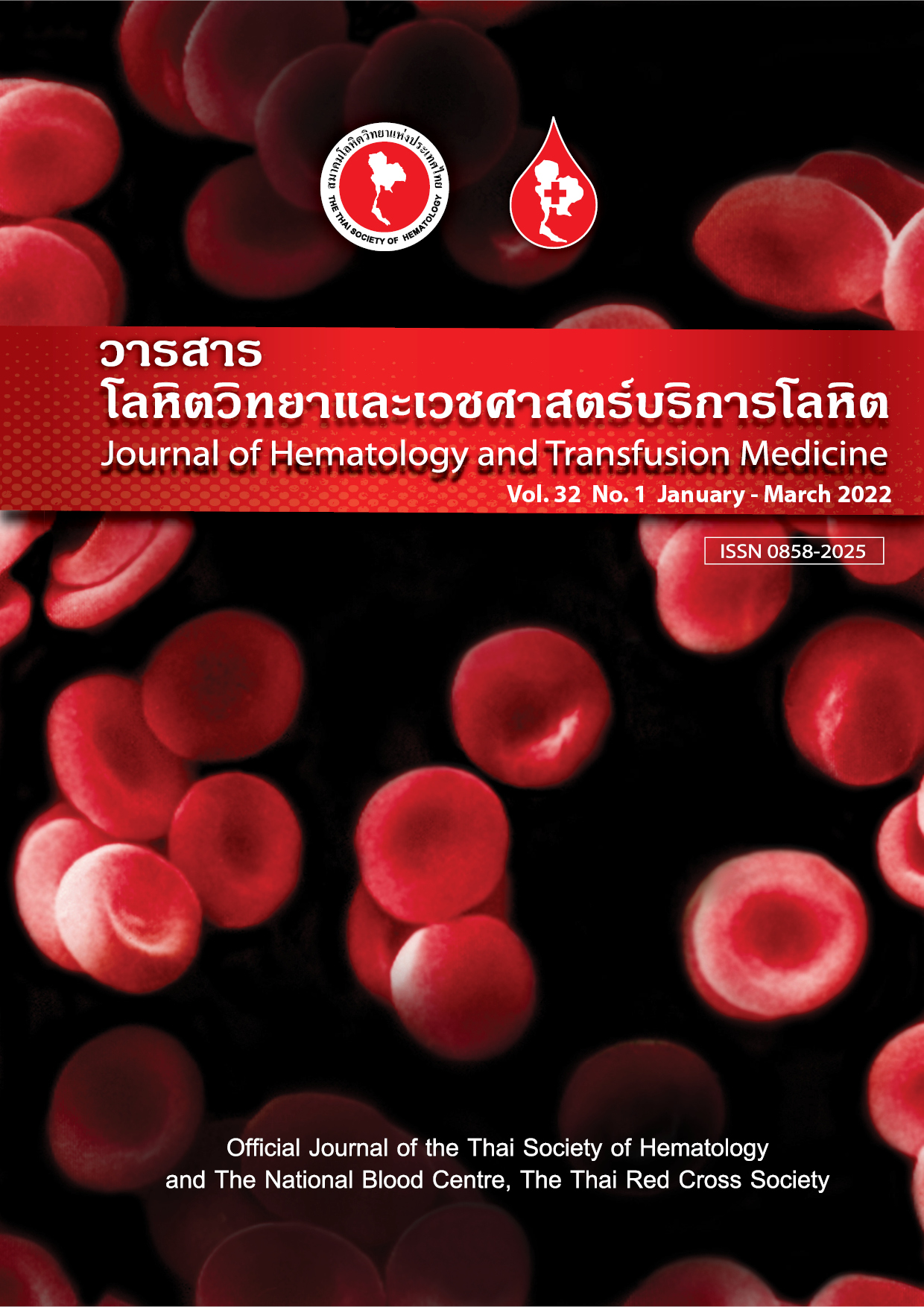Hematologic indices of autoimmune hemolytic anemia in adults: a retrospective study
ดัชนีทางโลหิตวิทยาที่พบในผู้ป่วยที่มีภาวะเม็ดเลือดแดงแตกจากอิมมูน
Keywords:
Autoimmune hemolytic anemia (AIHA), Reticulocyte count, Absolute reticulocyte count, Reticulocyte production index (RPI)Abstract
Abstract:
Background: Autoimmune hemolytic anemia (AIHA) is a rare condition of hemolytic anemia. Evaluation of hematologic indices such as hemoglobin (Hb), mean corpuscular volume (MCV), reticulocyte count (RC), reticulocyte production index (RPI) and absolute reticulocyte count (ARC) could improve outcomes of treatment.
Objective: The study aimed to evaluate hematologic indices such as Hb, MCV, RC, RPI, ARC in a patient with AIHA.
Materials and methods: Medical records were reviewed between 2011 and 2015 as a retrospective descriptive study. Data collections included personal demographics, disease characteristics, laboratory results, treatments, and treatment outcomes. Spearman’s correlation tests were used to correlate between RPI and factors. All data were analyzed using SPSS Software, Version 20, and p-value less than 0.05 was considered statistically significant.
Results: From 88 patients, the mean age was 60.17 (SD 18.92), and males were equal to the females. In all, 45 (51.1%), 18 (20.5%), 10 (11.4), 6 (6.8%), 6 (6.8%), and 3 (3.4%) patients received a diagnosis of idiopathic and infectious etiologies, systemic lupus erythematous (SLE), lymphoma, solid tumor and drug-associated AIHA, respectively. Most patients (92.1%) exhibited positive results of the direct Coombs test. Most (84.1%) patients had warm-type AIHA. The mean Hb, MCV, RPI and ARC at diagnosis were 7.27 g/dL (SD1.99), 83.61 fL (SD12.26), 0.82 (SD 0.68) and 79.11 x109/L (SD 58.20), respectively. RPI more than 2%, and ARC more than 100x109/L was found among 6 (6.8%), and 22 (25%) patients, respectively. RC positive correlated to RPI (r = 0.85, 95%CI: 0.75-0.91, p < 0.001), and ARC (r = 0.9, 95%CI: 0.83-0.94, p < 0.001). Moreover, RPI was positively correlated to systemic lupus erythematous (r = 0.235, p = 0.028, 95%CI: 0.023-0.396).
Conclusion: Idiopathic etiology was the common cause of AIHA. RPI and ARC were positive correlated to reticulocyte count among patients with AIHA, while RPI positively correlated to systemic lupus erythematous.
Downloads
References
Eaton WW, Rose NR, Kalaydjian A, Pedersen MG, Mortensen PB. Epidemiology of autoimmune diseases in Denmark. J Autoimmunity. 2007;29:1-9.
Valent P, Lechner K. Diagnosis and treatment of autoimmune haemolytic anaemias in adults: a clinical review. Wien Klin Wochenschr. 2008;120:136-51.
Hill QA, Hill A, Berentsen S. Defining autoimmune hemolytic anemia: a systematic review of the terminology used for diagnosis and treatment. Blood Adv. 2019;3:1897-906.
Phillips J, Henderson AC. Hemolytic anemia: evaluation and differential diagnosis. Am Fam Physician. 2018;98:354-61.
Hillman RS, Finch CA. Red cell manual: Philadelphia: FA Davis; 1985.
Liesveld JL, Rowe JM, Lichtman MA. Variability of the erythropoietic response in autoimmune hemolytic anemia: analysis of 109 cases. Blood. 1987;69:820-6.
Conley CL, Lippman SM, Ness P. Autoimmune hemolytic anemia with reticulocytopenia. a medical emergency. JAMA. 1980;244:1688-90.
Aladjidi N, Leverger G, Leblanc T, Picat MQ, Michel G, Bertrand Y, et al. New insights into childhood autoimmune hemolytic anemia: a French national observational study of 265 children. Haematologica. 2011;96:655-63.
Arbach O, Funck R, Seibt F, Salama A. Erythropoietin may improve anemia in patients with autoimmune hemolytic anemia associated with reticulocytopenia. Transf Med Hemother. 2012;39:221-3.
Pirofsky B. Clinical aspects of autoimmune hemolytic anemia. Sem Hematol. 1976;13:251-65.
Hill A, Hill QA. Autoimmune hemolytic anemia. Hematology Am Soc Hematol Educ Program. 2018;2018:382-9.
Hill QA, Stamps R, Massey E, Grainger JD, Provan D, Hill A. The diagnosis and management of primary autoimmune haemolytic anaemia. Br J Haematol. 2017;176:395-411.
Murphy S, LoBuglio AF. Drug therapy of autoimmune hemolytic anemia. Semin Hemaol. 1976;13:323-34.
Serrano J. [Autoimmune hemolytic anemia. Review of 200 cases studied in a period of 20 years (1970-1989)]. Sangre. 1992;37:265- 74.
Genty I, Michel M, Hermine O, Schaeffer A, Godeau B, Rochant H. [Characteristics of autoimmune hemolytic anemia in adults: retrospective analysis of 83 cases]. La Revue de medecine internet. 2002;23:901-9.
Go RS, Winters JL, Kay NE. How I treat autoimmune hemolytic anemia. Blood. 2017;129:2971-9.
Barcellini W, Fattizzo B. The Changing Landscape of Autoimmune Hemolytic Anemia. Front Immunol. 2020;11:946.
Sudulagunta SR, Kumbhat M, Sodalagunta MB, Settikere Nataraju A, Bangalore Raja SK, Thejaswi KC, et al. Warm autoimmune
hemolytic anemia: clinical profile and management. J Hematol. 2017;6:12-20.
Dara RC, Tiwari AK, Arora D, Mitra S, Acharya DP, Aggarwal G, et al. Alloimmunization in autoimmune hemolytic anemia patient: the differential adsorption approach. Asian J Transfus Sci. 2017;11:53-7.
Haspl ZH, Tomicić M, Grgicević D. Clinically significant red cell alloantibodies in patients with warm autoimmune hemolytic anemia. Acta Med Croatica. 2001;55:149-52.
Salama A. Treatment options for primary autoimmune hemolytic anemia: a short comprehensive review. Transfus Med Hemother. 2015;42:294-301.
Downloads
Published
Issue
Section
License
Copyright (c) 2022 Journal of Hematology and Transfusion Medicine

This work is licensed under a Creative Commons Attribution-NonCommercial-NoDerivatives 4.0 International License.



